Dylan Klebold's Death
An objective, thorough, evidence-based analysis of all evidence related to Dylan Klebold's death.

Key evidence items referenced
JCSO #903: “Intra-tec 9mm model TEC-DC9, semiautomatic pistol, S/N D076305, one round in chamber, live rounds in magazine.” [Source: Library, Team 2, p.12325]
JCSO #1093: The magazine found in the TEC-DC9M pistol.
JCSO #1096: The live round found in the TEC-DC9M chamber.
JCSO #8680/CBI #261: The 9mm shell casing from the bullet that killed Klebold (Firearm Discharge #11) However, a researcher recently discovered that this may not actually be the shell casing. This page will be updated in due time!
Why do people question Dylan Klebold's death?
Although Dylan Klebold’s death was ruled a suicide, some people believe Harris killed Klebold.
This claim was first published in 2002 in the National Enquirer alongside two leaked crime scene photos of the shooters’ bodies.
However, the evidence doesn’t support this conclusion (and neither do the photos). The documented evidence and photos suggest Harris died first, which means he could not have killed Klebold.
On this page, you’ll find out why. You’ll also discover a shocking revelation about the leaked photos that will change everything you think you know about the crime scene.
First, let’s take a quick look at why people believe Harris killed Klebold.
Spoiler: There is no TEC-DC9M in the leaked photos
Myth: The "suicide photos" leaked to the National Enquirer show the TEC-DC9M under Klebold's leg and right hand.
Evidence-based truth: There is no TEC-DC9M in the leaked photos; it was removed from the scene hours earlier.
This misperception is an optical illusion created by the leaked photos that imply the gun is under Klebold's right hand in the photo. In fact, there is no TEC-DC9M in the leaked photos. It has already been removed from the scene. Only the strap is under Klebold's hand.
When Klebold's body was found, both the TEC and his hand were concealed under his leg. In the leaked photo, the TEC's strap has been visibly cut and the pistol has been removed, which is why his right hand is now completely visible. When found, his hand was concealed underneath his leg.
This will be discussed in detail later.
Did Eric Harris kill Dylan Klebold?
Those who believe Harris killed Klebold generally hold the following misconceptions:
Myth #1: “The Death Grip"
“Klebold was found tightly gripping the TEC-DC9M in his right hand, which means either someone planted the pistol in his hand or he was shot while already holding onto the pistol.”
Myth #2: The “Trajectory Dilemma”
“Klebold could not have achieved the fatal bullet’s trajectory through his left temple using his right hand, therefore Harris killed Klebold and then planted Klebold’s right hand over the TEC-DC9M to make Klebold’s death appear as a suicide.”
Myth #3: “The Murder Weapon”
“Harris killed Klebold with the Hi-Point rifle, not the TEC-DC9M, and there’s no proof the fatal bullet came from the TEC-DC9M.”
Myth #4: “The Missing Magazine”
“The TEC-DC9M was found without a magazine and a live round in the chamber. If Klebold killed himself with this pistol, it had to have a magazine attached to load that last round into the chamber. There was no magazine, therefore, suicide with the pistol is impossible.”
ALL of these claims are demonstrably false.
The evidence-based truth in summary
"The Death Grip"
- Klebold was not found “tightly gripping” the TEC-DC9M. His fingers were "slightly curved" over the grip (the gun was upside-down with his pinky finger close to the trigger box).
"The Trajectory Dilemma"
- The fatal trajectory would have been easy for Klebold to achieve via suicide and the fact that the TEC was found under his right hand has no bearing on what hand pulled the trigger because (1) the gun was upside down under his palm, which means if someone 'planted' the gun under his hand, they planted it upside-down, which makes no sense. And (2) the gun was attached to a strap around his body and would have fallen from his grip, remaining close to his body no matter how he (or anyone else) pulled the trigger.
“The Murder Weapon”
- The TEC-DC9M unquestionably fired the fatal shot (not the carbine). There was drawback in the barrel of the TEC matching Klebold's DNA, which means the fatal shot came from the TEC. The fatal bullet came from Firearm Discharge #11.
“The Missing Magazine”
- The TEC-DC9M was found with a loaded magazine attached.
Now let’s look at each claim in-depth.
Point #1: The Death Grip
Myth: “Klebold was found tightly gripping the TEC-DC9M in his right hand, which means either someone planted the pistol in his hand or he was shot while already holding onto the pistol.”
Evidence-based truth: Klebold was not found tightly gripping the TEC-DC9M.
JCSO detective Jim Jennings documented Klebold’s fingers as being “slightly curved” with his palm down. [Source: CBI Crime Scene Report, Team 2 p.3]
 |
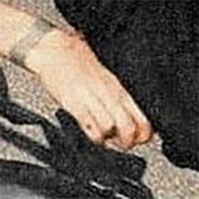 |
|---|
This doesn’t look like a tight grip. Klebold's index and middle fingers are loosely curved and his middle finger is so loose that you can see the inside of his finger. You could probably stick a toothbrush through his pointer and middle fingers they’re so open. This is not a tight grip.
Other than this handwritten note, there are only three other places where the gun is described being in Klebold’s hand. None mention Klebold 'gripping' or 'tightly gripping' the pistol:
(1) States the gun was “in the right hand and under the right leg of Klebold” [Source: Library, Team 2, p.12302]
(2) States the gun was “removed from Klebold’s right hand” [Source: Library, Team 2, p.12302]
(3) States his “right hand was around the grip of the Tec-9 pistol” [Source: Library, Team 2, p.12303]
There is no documented evidence stating Klebold was tightly gripping or even gripping the pistol. The documented evidence states the opposite - that the grip of the pistol was found under his palm and his fingers were “slightly curved” over the top.
Slightly curved fingers do not constitute a grip.
The idea that Klebold was found “tightly gripping” the TEC-DC9M comes from a misperception of one of the leaked crime scene photos.
Some people look at the photo and see a “tight grip.” However, upon close examination, it’s clear that Klebold’s hand is not gripping anything (furthermore, there is no gun in this photo, and his hand is over a section of bunched-up strap). Klebold’s fingers are so loosely curved that the back of his hand and knuckles are flat and the inside of his middle finger tip is partially visible.
A flat hand and loose fingers can’t be gripping anything. Forming a grip causes your fingers and the back of your hand to form a 90-degree angle. Klebold’s hand is flat - only his fingers are slightly curved, as was documented.
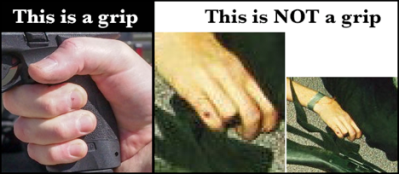
Why does it matter if Klebold’s hand was tightly gripping the pistol?
When you think he was found “tightly gripping” the pistol, the next question is, “why would he be gripping the pistol with his right hand when it would have been impossible for him to shoot himself with his right hand? Eric must have killed him!” This conclusion is based on a faulty premise.
When a gunshot victim is found gripping a gun in their hand, there are only 4 ways the gun could have gotten into their hand:
[1] They were holding the pistol at the time of death. If they are believed to have committed suicide, gripping the gun suggests they pulled the trigger with the hand left holding the gun.
[2] They were holding the gun while they were shot or committed suicide with a second gun.
[3] Somebody planted the gun in their hand.
[4] They grabbed the gun after they were shot.
In Klebold’s case, the misperception that he was found tightly gripping the pistol makes people wonder how he could have committed suicide by using his right hand to shoot himself in the left temple. The angle is impossible. This much is true. However, he wasn’t found gripping the pistol, so there’s no reason to presume suicide by his right hand is how the gun got underneath his fingers.
That Klebold's hand was over the pistol is meaningless because (1) the gun was upside-down under his palm with his pinky finger near the trigger (not in a firing position), and (2) the gun was on a strap, so of course it would stay close to the right side of his body as he fell on his right side.
Why were Klebold’s fingers curved?
While the common assumption is that Klebold’s fingers are curved over the grip because he died holding the gun, that may not be the case. Klebold’s fingers most likely became curved because of rigor mortis. Fingers naturally curl as if they are holding something after a person dies.
Also, some people’s fingers start to curl days or weeks before they pass. Even though they aren’t in rigor, their fingers become frozen in a curled position that gradually becomes more pronounced, which is how medical professionals know death is imminent for some patients.
Did Harris plant the pistol in Klebold’s hand?
The “death grip” misperception gives rise to the next assumption: that Harris killed Klebold and planted the gun in his right hand. How else could the pistol have gotten into his right hand if he couldn’t have shot himself right-handed? Doesn’t that mean the pistol was planted?
There is no evidence that suggests the pistol was planted in Klebold’s right hand. There’s a reasonable explanation for how Klebold’s fingers could have ended up “slightly curved” over the grip even if he didn’t shoot himself with his right hand. This will be addressed in detail shortly, but basically, he could have fallen on the pistol and grabbed around for it while he was on his back, still alive.
Point #2: The Trajectory Dilemma
Myth: “Klebold could not have achieved the fatal bullet’s trajectory through his left temple using his right hand, therefore Harris killed Klebold and then planted Klebold’s right hand over the TEC-DC9M to make Klebold’s death appear as a suicide.”
Evidence-based truth: The premise is true, but the conclusion is false.
It’s presumed that the only way the pistol could have gotten under Klebold’s right fingers was if he held onto the pistol after killing himself. Since the wound angle would have been impossible to achieve by firing the pistol with his right hand, the conclusion is that someone planted the pistol in his hand. This conclusion is based on faulty reasoning.
The angle would have been possible to achieve via suicide, but only in certain ways. For example, he could have held the pistol with two hands and pulled the trigger. Regardless of what hand or finger he used to pull the trigger, the pistol would have dropped to his side, still attached to the strap, and pulled toward his right side since that’s the direction his body fell. From there, he could have placed his right hand over the pistol after he fell.
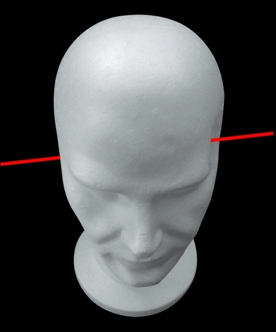
This is the approximate trajectory of the bullet that killed Klebold. Since we don’t have autopsy diagrams, it’s hard to determine the exact points of entry and exit. However, the trajectory was not a 90-degree angle and the gun was not touching his head.
Dr. Ben Galloway, the coroner who examined Klebold’s body, described the wound:
“The projectile penetrated the cranium through the left temporal bone; extended across the undersurface of both cerebral hemispheres; exiting the head through the right temporal bone…
The projectile traveled left to right slightly front to back and slightly downward. The characteristics of the wound are consistent with a large caliber weapon; with a close contact range of fire; consistent with self-infliction.”
[Source: Klebold’s autopsy report]
This angle would not have been possible for Klebold to achieve by firing the pistol with his right hand into his left temple. However, Klebold could have easily achieved this angle with both hands.
What is a close contact wound?
A “close contact range of fire” does not involve contact between the firearm and the subject. In general, by most standards, a “close contact” range can be anywhere from 15cm-60cm, depending on how far the firearm projects its flame. However, there is no actual contact between the barrel and the person’s body.
The orientation of the pistol under Klebold’s hand matters
There’s one more critical detail. It’s already established that Klebold was not gripping the pistol. It’s equally important to note the orientation of the pistol under Klebold’s fingers. The orientation of the pistol under Klebold’s fingers is upside-down, which suggests his right hand ended up over the grip after he fell to the ground. If he continued to hold onto the pistol after firing a shot into his head, he was holding the pistol upside-down when he pulled the trigger, which doesn't make sense.
Let’s look at this in-depth.
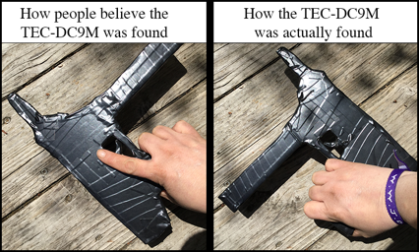
When found, Klebold’s right fingers were slightly curved over the grip of the pistol, but the gun was upside-down.
Look closely at the photo on the right. The pinkie finger is at the top near the trigger box, while the pointer finger is at the bottom of the grip. This is how the pistol was found under Klebold's hand. This position is not a firing position. People don't fire guns upside-down. If you did, you would have to use your pinkie finger to pull the trigger.

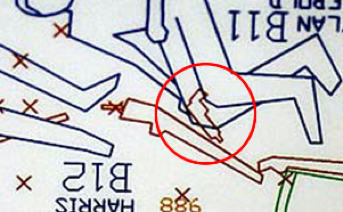
 |
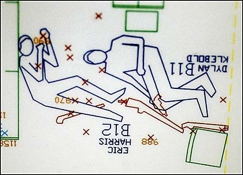 |
|---|
Why does it matter that Klebold’s hand was found backwards over the grip? It answers the question of, “how did the pistol get under his fingers?”
The pistol came to be in his right hand after he fell to the floor. (This is the only possibility).
Now we can be certain that Klebold didn’t shoot himself with the pistol in his right hand and fall to the floor while still gripping the pistol. This doesn't mean he didn't use his right hand or both hands. It just means if he shot himself, the pistol fell out of his hand(s) and he moved his right hand over the grip when he landed on the floor on top of the pistol.
It doesn’t mean he didn’t shoot himself. It doesn’t mean he was murdered. That’s a separate subject.
It simply means that the combination of: suicide with a backwards grip+hand remaining on the grip as he fell=impossible. In other words, we can be certain Klebold didn’t commit suicide and then fall to the floor with the pistol still in his hand.
Was the pistol planted in Dylan’s hand by someone other than Harris?
The next question is: Did Klebold put his hand over the pistol after the fatal shot, or did someone plant it in his hand?
The false belief that Klebold was found “tightly gripping” the pistol, and the misperception that the pistol was right-side-up are the only reasons to consider that someone may have planted the pistol in his hand. Since these are both false, there’s no reason to suspect the pistol was planted.
Gravity likely pulled the pistol to Klebold’s right as he fell
How could the pistol have gotten underneath Klebold’s right fingers if he shot himself using his left hand?
The pistol was on a strap that went around Klebold’s shoulder and connected to his waist. After firing the pistol, if the recoil knocked the pistol out of his hand, the pistol’s movement would have been restrained and gravity would have pulled it in the same direction he fell (to his right).
We know Klebold briefly rested on the right side of his face, then rolled over and aspirated blood before he died. According to his autopsy report, he was capable of some involuntary movement. It’s possible that he grabbed at the pistol with his right hand after rolling over. He may not have lost consciousness right away.
Klebold’s wound was found ‘consistent with suicide’
Klebold's wound was found to be "consistent with suicide," but there's something contradictory about what Dr. Galloway described in the autopsy report. He wrote, "The projectile traveled left to right slightly front to back and slightly downward. The characteristics of the wound are consistent with... self-infliction.”
According to decades of research, a downward bullet path is indicative of homicide, not suicide.
From a study published in 2002 titled Autopsy features relevant for discrimination between suicidal and homicidal gunshot injuries:
"Consequently, some bullet path directions cannot be considered indicative of suicide: downwards and back-to-front in gunshots to the temple, left-to-right in gunshots to the left chest and downwards in mouth shots. The isolated autopsy findings can only be indicative of suicide or homicide but the combined analysis of several findings can be associated with a high probability."
It's also uncommon for suicides to have no barrel contact, although it does happen. It's just rare. Given the weight and size of Klebold's pistol combined with an angle that would have bent his wrists unnaturally inward, it's hard to believe he shot himself with one hand pulling the trigger. His long arms wouldn't factor into the strain on his wrists. He would have had to curl his left wrist inward extremely hard to get the barrel of the gun to point slightly front-to-back while still allowing him to pull the trigger. (If you make a model TEC to scale you can see for yourself).
Klebold has two unusual wound characteristics for a suicide
No contact with his head and a downward bullet path.
Although these points should be taken into account - a downward bullet path by itself, and a lack of barrel contact - it doesn't mean Klebold was killed. It's possible that he engaged in a rushed, sloppy suicide where he grabbed the pistol with two hands, didn't press the barrel to his head, and pulled the trigger quickly as he moved the gun to his temple.
Could Klebold have achieved this angle via suicide?
While he couldn’t have achieved the documented trajectory by pulling the trigger with his right hand only, it would have been easy and natural for him to achieve the documented trajectory via self-infliction while holding the gun with both hands.
Possibilities: (1) He could have held the grip with both hands, right hand on the bottom, pulling the trigger with his left thumb… or (2) He could have held the magazine in his right hand, the grip in his left hand, pulling the trigger with his left thumb or index finger.
If holding the magazine sounds like an awkward way to commit suicide, it’s not. It’s actually the most natural way to turn a TEC-9 on yourself.
Why would Klebold hold the magazine (if he did?)
The TEC-DC9M magazine is forward of the grip, making the pistol unbalanced and front-heavy. In the absence of a mounted forward pistol grip, which is illegal, people commonly fire TEC-9 models by holding the magazine in their non-dominant hand.
It would have been natural for Klebold to hold the magazine in his right hand with his left hand on the grip. From there, it would have been a simple, natural movement to turn the gun on himself and fire the fatal shot pulling the trigger with his left hand while still holding the magazine in his right hand to steady the shot. After that, the gun would have fallen, but since it was on a strap, it would have stayed close to his body as he fell.
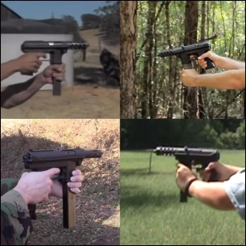
If Klebold held his pistol this way, it would have been natural and easy to turn the gun to his left temple at the documented angle and pull the trigger while achieving the documented angle. Plus, holding the magazine would have countered the downward pull from the loaded magazine's weight.
Now it’s easy to see how a litany of false beliefs are predicated on a simple misperception of the crime scene (a “tight grip”).
And we’re just getting started.
Why are these false beliefs so pervasive? Some people are looking at the case with an inherent bias, knowing the police made several big mistakes, and they’re actively looking for cover-ups… so that’s what they see. Even when the documented evidence is right in plain sight. Other people see an optical illusion in the leaked photos, which will be addressed shortly.
Note: I adopted many of these mistaken beliefs, too, in the beginning of my research. I’m the one who published that the TEC-DC9M was found without a magazine in the early days because I read the documentation wrong. However, after leaving the case for almost 8 years, I came back with a fresh perspective and began analyzing objectively. Since I was no longer attached to the case I was able to see the truth and saw how my beliefs were wrong. And that’s why I decided to make this page.
Point #3: The Murder Weapon
Myth: “Harris killed Klebold with the Hi-Point rifle, not the TEC-DC9M, and there’s no proof the fatal bullet came from the TEC-DC9M.”
Evidence-based truth: The TEC-DC9M unquestionably fired the fatal shot that killed Klebold.
The TEC-DC9M had 1 to 1/2” of drawback (blood) in the barrel matching Klebold’s DNA.
“The DNA profiles developed from items #23A and 23C (TEC 9 pistol) matched the DNA profile from Klebold.” [Source: CBI; DNA Reports p.53]

Drawback is a specific phenomenon that would only be present if the fatal shot was fired from the TEC-DC9M. Drawback doesn’t flow into a muzzle from a pool of blood (note: the pistol was never in a pool of blood). Drawback comes from the entry wound. When the bullet impacts the body, the blood travels backwards into the barrel along the bullet's path. However, drawback doesn't always occur.
Some have said the blood in the pistol’s muzzle is just “traces of blood.” That is false. Drawback is not the same as “traces of blood.” “Trace evidence” refers to small, minute, often microscopic amounts of evidence. There is nothing minute or microscopic about 1 to 1/2 inches of drawback in the barrel of the TEC-DC9M.
“There was a flow pattern extending inside the barrel muzzle about 1 to ½ inches.” [Source: CBI, Trace Arson page 3 of 77 & Evidence Volume 2; CBI Reports, p.12112]

Drawback matching Dylan's DNA was found in the TEC-DC9M
The CBI lab report documented:

Some people wonder if the Hi-Point rifle also had blood in the barrel that may have matched Klebold’s DNA. It did not.
The Hi-Point rifle was documented as having “no visible bld in barrel.” [My apologies for not saving the page number for this note! When I find it, I will correct it asap.]
Unlike the TEC-DC9M, which had 1 to 1/2 inches of drawback matching Klebold’s DNA in the muzzle, the Hi-Point rifle had no visible blood in the barrel.
The absence of blood in the barrel doesn’t mean much on its own. The absence of evidence is not, itself, evidence. However, it’s important to cover all bases regarding the firearms and note that Dylan’s blood was not found inside the Hi-Point rifle’s barrel.
What bullet killed Klebold?
The bullet that killed Klebold was allegedly never recovered (it's not in the documentation). However, the 9mm shell casing from the bullet that killed Klebold (JCSO #8680/CBI #261 & Firearm Discharge #11) was recovered, no DNA was found and it wasn’t traced to a specific gun. [Sources: CBI, Team 2, p.370; Evidence Vol. II p.12206; Library Team 2, pp.12316-17]
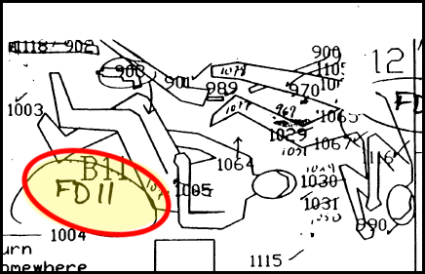
Firearm Discharge #11 was found next to Klebold’s body. [Source: Library Team Two p.12809]
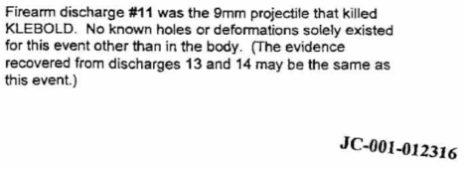
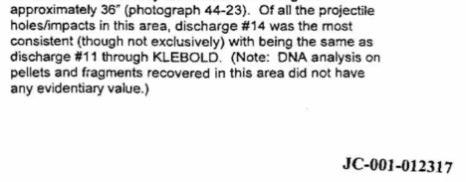
There’s just one problem with discharge #14 being the hole/impact from the bullet that killed Klebold: it’s in the wall under one of the windows. This would mean the fatal shot was fired from the bookshelves toward the window. With that trajectory, the bullet would have gone through Klebold’s right temple. Klebold’s entry wound was in his left temple, and the bullet traveled from the direction of the windows toward the bookshelves. Hole/impact #14 is the exact opposite trajectory of the bullet that killed Klebold.
The bullet that killed Klebold was fired from the TEC-DC9M
There is no evidence that suggests or supports the belief that Klebold was killed with the Hi-Point rifle or any other firearm.
All physical evidence supports the TEC-DC9M as the pistol that fired the fatal shot.
Point #4: The Missing Magazine
Myth: “The TEC-DC9M was found without a magazine and a live round in the chamber, which makes a suicide impossible. If a magazine was attached to the TEC when found, surely it would be visible in the leaked photos, but there is no magazine visible.”
Evidence-based truth: There is no missing magazine. Klebold's TEC-DC9M was found with a loaded magazine attached and one round in the chamber. The reason no magazine is visible in the leaked photos is because there is no magazine (and no pistol) in the leaked photos. This will be discussed in-depth later.
The TEC was found with a loaded magazine
The TEC-DC9M was found with a magazine in the pistol containing live rounds. The live round found in the chamber was fed from the loaded magazine after the fatal shot was fired. The magazine was inserted into the pistol when Klebold’s body was found. Nobody removed the magazine; it was in the pistol.
The magazine with live rounds found in the TEC-DC9M pistol is JCSO evidence #1093.

Page 12325 from the Library Teams 1-7, Team Two report describes the condition of each weapon as it was found.
The TEC-DC9M is described as being found with “one round in chamber, live rounds in magazine.”
The original handwritten notes documenting the condition of the firearms found, including whether the safety was on or off, can be found in the CBI documents.

Above is the original handwritten note documenting the condition of the pistol as found.
The notes read: “loaded mag 1 in chamber safety? NO.”
[Source: CBI; Crime Scene Report Team Two, p.347]
Why does it matter if there was a magazine in the TEC-DC9M?
A live round in the chamber of the TEC-DC9M indicates the last shot was fired while a magazine was attached. After each shot from a semi-automatic pistol, a round is loaded into the chamber, fed from the magazine. A pistol won’t load a new round in the chamber without a magazine attached. No magazine would mean either (a) someone removed the magazine after the fatal shot was fired or (b) the fatal shot wasn’t fired from the TEC-DC9M.
If Klebold shot himself with the TEC-DC9M without a magazine inserted, he would have fired the last remaining bullet from the chamber and the chamber would be empty.
However, all of these points are irrelevant since the TEC-DC9M was, in fact, found with a loaded magazine.
Three false conclusions are drawn from the false belief that the TEC-DC9M was found without a magazine:
(1) Klebold couldn’t have killed himself with a pistol that didn’t have a magazine attached and feed a live round into the chamber. (True, but the pistol was found with a loaded magazine so this conclusion is invalid)
(2) The only other person in the room was Harris, therefore Harris killed Klebold. (This is an assumption and is demonstrably false)
(3) Without a magazine attached, the TEC-DC9M could not have been the weapon that fired the fatal shot. Unless the person who fired the fatal shot removed the magazine afterward and placed the pistol in Klebold’s hand. (True, but the TEC-DC9M was found with a magazine attached and was the gun that fired the fatal shot, which makes this conclusion invalid)
How we know the magazine was inserted into the pistol when found
How do we know the pistol wasn’t just collected with a magazine lying nearby and that’s why the description of evidence collected includes a magazine?
That’s a great question easily resolved by understanding what investigators are documenting when they document the condition of a firearm.
Documenting the condition of a firearm found at a crime scene includes documenting the position of visible features like the safety, action, hammer, presence of a live round in the chamber, and the presence of a magazine.
If something is not attached to the firearm, it is not included as part of the firearm’s condition. When a magazine is nearby and not attached to the firearm, it is documented as evidence, but is not considered part of the firearm’s condition.
The condition of the TEC-DC9M was documented with a loaded magazine, which means the magazine was inserted into the pistol when it was recovered from Klebold’s body.
The scene recovery log also lists a magazine with live rounds, item #1093, as being found inside the TEC-DC9M.
The documented condition of the TEC-DC9M, plus the scene recovery log proves the magazine was inserted into the TEC-DC9M when recovered by investigators.
If you’re still not convinced the magazine was inserted into the TEC, consider that Harris’ rifle was documented as ‘empty,’ yet a rifle magazine was located right next to the firearm. The rifle’s magazine was not documented as part of the rifle’s condition. Only an inserted magazine would be documented as part of a firearm’s condition when found.
 |
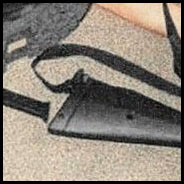 |
|---|
Likewise, Harris’ shotgun had one round left in the internal tube magazine and a spent round in the chamber, and was documented as such. Harris’ shotgun had a 4+1 round capacity.
What about the CBI document that says there was no magazine?
Isn't there a CBI document that documented the TEC-DC9M as being received without a magazine?
This document exists, but has nothing to do with the crime scene. This is a lab receipt.
The CBI document in question is not crime scene documentation.
There is no discrepancy.
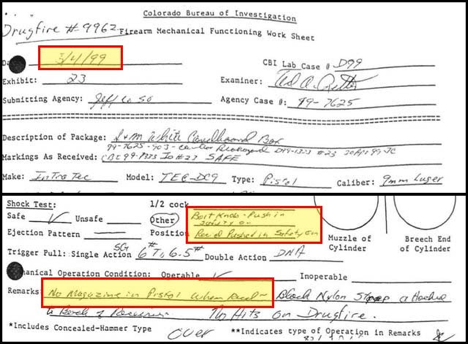
This receipt was created to document the condition of the TEC-DC9M as it arrived in a box to the lab on 5/4/99 to be test fired. This is not crime scene documentation - it is a CBI lab receipt.
As per CBI transport requirements, the magazine was removed and the safety was engaged for transport to the CBI lab. The document reads: “Bolt knob - Push in safety on Rec’d Pushed in Safety on.” And “No Magazine in Pistol when Rec’d~”
Why was the magazine removed before sending the pistol to the CBI?
The CBI officially requires all firearms to be unloaded before being shipped or transported to their facility. Magazines must be detached before being transported even in a vehicle.
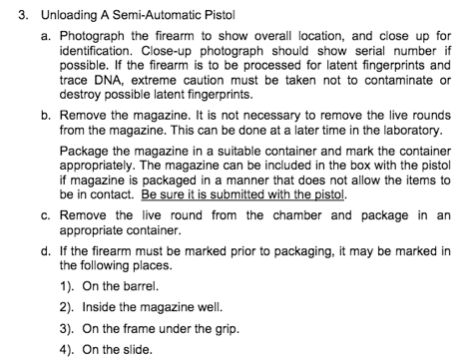
Above is an excerpt from a document titled Physical Evidence Handbook created by the Colorado Bureau of Investigation (CBI). The authors include Chris Andrist, Alan Hammond and Tom Griffin - three officials who worked on the Columbine case. Hammond and Griffin were two of three people who removed the TEC-DC9M from Klebold’s body.
The document describes the requirement to unload a semi-automatic pistol and remove the magazine prior to transporting/mailing it to the CBI for testing.
It notes:
[3-b] “Remove the magazine.”
[3-b] “The magazine can be included in the box with the pistol if magazine is packaged in a manner that does not allow the items to be in contact. Be sure it is submitted with the pistol.”
[3-c] “Remove the live round from the chamber and package in an appropriate container.”
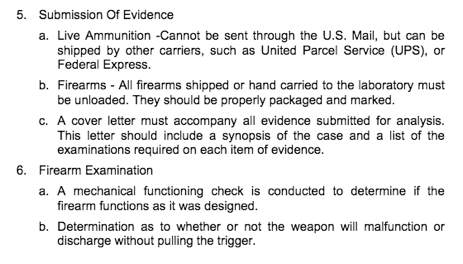
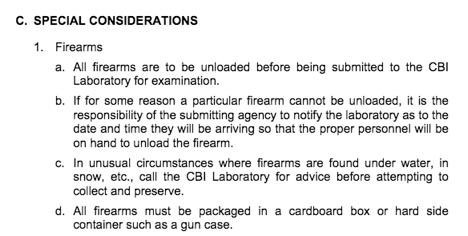
[5-b] “All firearms shipped or hand carried to the laboratory must be unloaded.”
[1-a] “All firearms are to be unloaded before being submitted to the CBI Laboratory for examination.”
To recap:
The CBI document is a receipt from 5/4/99 for the pistol submitted to the CBI by Jeffco in order to have the pistol tested.
To ensure a safe transport and preserve evidence, as per the CBI’s rules, the magazine was ejected and the pistol and magazine were packed separately in a box for transport. The live round in the chamber had already been removed from the pistol at the scene on April 21, 1999.
When the CBI received the box, they documented the contents and condition of the firearm as per their policy.
This is a receipt, not crime scene documentation, and is irrelevant to how the TEC-DC9M was found at the scene.
At the crime scene, the pistol was found with a loaded magazine and the safety was not engaged.
The live round found in the chamber of the TEC-DC9M
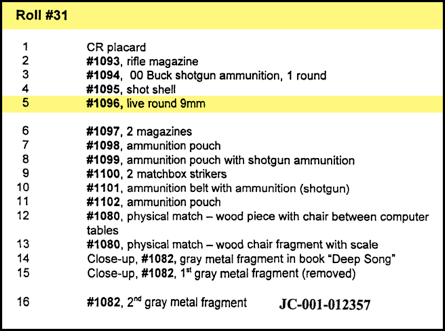
Item #1096 is the live round found in the TEC-DC9M chamber.
You might be wondering how we know the live round was removed from the chamber prior to transporting the pistol to the CBI lab since the receipt doesn’t specify if a round was chambered or not.
The live round was removed from the TEC-DC9M chamber on April 21, 1999 and was photographed by Team Two on Roll #31.

Why do people believe the TEC was found without a magazine?
The belief that the TEC-DC9M was found without a magazine is based on four misinterpretations:
Misinterpretation #1: “The leaked crime scene photos depict the scene as found, entirely untouched.”
This gives rise to the second misinterpretation…
Misinterpretation #2: "The pistol isn’t visible in the photo because it’s hidden underneath Klebold’s right leg.”
This gives rise to the third misinterpretation…
Misinterpretation #3: “Since the pistol is hidden under Klebold’s right leg, the magazine should be visible. The magazine isn’t visible in the photo, therefore the pistol wasn’t found with a magazine and the evidence logs and diagrams are all wrong.”
Misinterpretation #4: “The crime scene diagrams and sketches don’t depict a magazine, either. If the pistol were found with a magazine, the sketch artist (Laura DeLong) would have drawn the magazine.”
All four misinterpretations arise from a series of false assumptions based on a single misperception of the leaked crime scene photos. The misperception being that there is a pistol in the photo. In the leaked photos, there is no TEC-DC9M pistol. It has already been removed from Klebold’s body, and this will be addressed in detail shortly.
What's under his hand? Klebold's hand is resting over the strap.
Why is the strap under Klebold's hand?
The TEC-DC9M has a single sling point mount for the strap on the back of the pistol. When investigators removed the pistol from underneath Klebold's right hand, there would be a section of strap next to his hand. It makes sense that after removing the pistol, his hand would then naturally come to rest on top of the strap.
Let’s address all four of the above misinterpretations.
Misinterpretation #1: The leaked crime scene photos depict the scene as found, entirely untouched.
Evidence-based truth: Yes and no. The leaked crime scene photos depict a post-bomb sweep scene where firearms have been moved and Klebold’s right arm has also been pulled out from underneath his body for the purpose of removing the pistol. However, the bodies have not been moved in any other way.
How do we know this? We have pictures that match the documentation.
Note: That the leaked photos depict a scene that has been altered doesn't mean the scene was "tampered with." On the contrary, photos are taken throughout every stage of processing the scene, and the leaked photos happen to have been taken in the middle, not during the initial walkthrough. This isn't sinister. Not every crime scene photo is going to represent an untouched scene.
To prove that the leaked crime scene photos do not depict the entirely untouched original scene, let’s compare one of the leaked photos with a pre-bomb sweep photo.
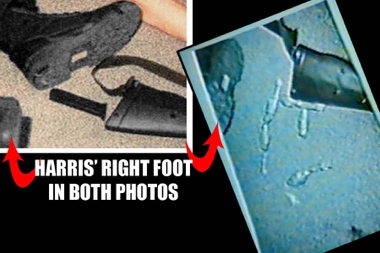
On the left is the leaked crime scene photo depicting Harris’ boots, the Hi-Point rifle, the rifle’s strap, and a rifle magazine. On the right is a crime scene photo taken from a presentation depicting the crime scene before the first two bomb sweeps.
In the second photo, CO2 bombs, aka ‘crickets’ can be seen by the rifle and are not present in the first photo. This proves the leaked photos do not depict the original scene and were taken post-bomb-sweep. However, the bomb technicians did not move the suspects’ bodies during the bomb sweeps. Only Klebold’s right arm was moved when two investigators and the coroner removed the pistol from his body.
So what if the leaked photos were taken post-bomb-sweep? What does that have to do with the TEC-DC9M magazine?
The CO2 cartridge bombs (“crickets”) aren’t the only pieces evidence investigators moved/removed from the scene prior to taking the leaked photos.
Three of the four firearms have been moved in the leaked photos
The TEC-DC9M, Hi-Point rifle, and double barrel shotgun were all moved prior to the leaked photos being taken. None of these firearms are in their original positions in the leaked photos.
In addition to the presence/absence of crickets, there are two important differences between these photos.
In the photo on the right, taken before the first bomb sweep when crickets were removed, the rifle’s strap is lying over the rifle magazine. The rifle is also several inches closer to Harris’ right boot.
In the photo on the right, the rifle magazine lines up with the top edge of the rifle’ stock and the strap is over the magazine. In the photo on the left, the rifle magazine lines up with the bottom edge of the rifle’s stock and the strap is not over the magazine.
SUMMARY: The leaked photos were taken after two bomb sweeps and after the Hi-Point rifle was moved from its original position.
That’s not all…
You might be wondering if these two photos are just flipped and it only appears that the Hi-Point rifle has been moved.
Look closely. Here’s how we know these photos are different angles of the same scene and have not been flipped.
Look at the top of the rifle. You can see the slightly curved surface of the top of the rifle’s stock in the same position in each photo.
Also, in both photos, the rifle’s strap is at the top of the stock, proving both pictures are the same orientation and have not been mirrored or flipped.
Klebold’s shotgun was moved from its original position
Klebold’s double barrel shotgun has also been moved from its original position in the leaked photos. We don’t have access to the original photos, but we don’t need original photos to know the shotgun has been moved.
When Klebold’s shotgun was found, the action was open. In the leaked photo, the action is closed. Before investigators took the leaked photos, they moved 3 out of 4 firearms - the rifle, the TEC pistol, and the double barrel shotgun.
Why?
The most logical explanation is that it was part of their routine to clear the chambers to make the scene safe. They wouldn't have touched Eric's shotgun at that point because it was underneath his leg, and at that time, they still had not moved the bodies.
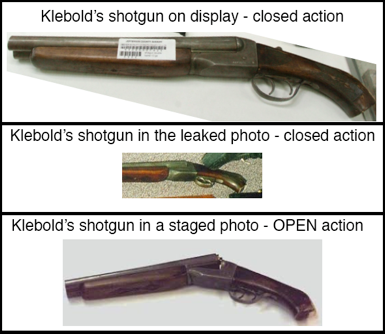
Note: the crop from the leaked photo has been horizontally flipped to match the orientation of the other photos to make it easier to see that the action is closed.
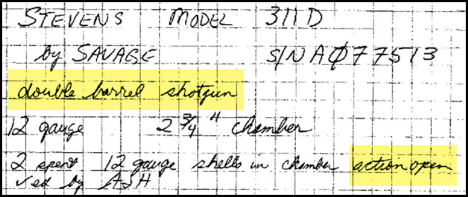
[Source: CBI; Crime Scene Report Team Two, p.347]
Klebold’s right arm has been moved in the leaked photos
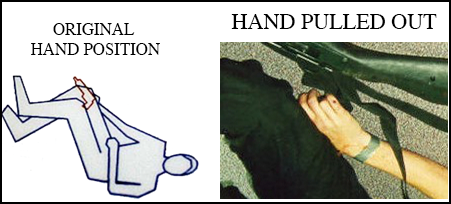
The TEC-DC9M, along with Klebold’s right arm, have also been moved from their original positions in the leaked crime scene photos.
When Klebold’s body was found, his right hand was concealed underneath his right leg, along with the TEC-DC9M pistol.
In the leaked photo, you can see Klebold’s hand is fully visible. This is not how he was found. In the leaked photo, investigators have pulled his right hand out from underneath his leg.
Why did investigators pull his right hand out from underneath his leg?
They didn’t move his arm to check for bombs.
Investigators did not move Klebold’s body during the bomb sweeps. Statements to the contrary are rumors.
The bomb squad documented that they did not move any bodies during the first bomb sweep and investigators were instructed not to touch the bodies at the time of the second bomb sweep.
“The sweep was done to determine if there were any additional live IEDs (with the exception of any more that would be found on the bodies of KLEBOLD and HARRIS, which had not been moved at this time). [Source: 11k Witness Testimony; Glen Grove, JCSO Bomb Squad p.7811]

“At 1947 hours… bomb personnel were still working on making devices safe, and making another sweep of the building… the Jefferson County Coroner would be in charge of identifying the bodies and we were not to touch the bodies.”
So… why’d they move his arm if not to look for bombs?
This brings us to…
Misinterpretation #2: The TEC-DC9M pistol isn’t visible in the photo because it’s hidden underneath Klebold’s right leg.
What comes next is the single misperception that gives rise to all of the other misinterpretations.
Evidence-based truth: Investigators pulled Klebold’s right hand out from underneath his leg to remove the TEC-DC9M pistol from his body.
The leaked crime scene photos depict the scene after the TEC-DC9M pistol has been removed from Klebold’s body.
There is no pistol in the leaked photos
It is an optical illusion.
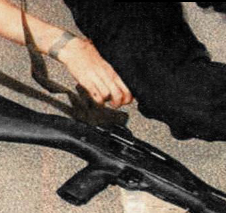
This brings us to…
Misinterpretation #3: Since the pistol is hidden under Klebold’s right leg, the magazine should be visible. The magazine isn’t visible in the photo, therefore the pistol could not have been found with a magazine.
Evidence-based truth: The magazine isn’t visible in the photo because there is no pistol in the photo.
The leaked photo is not from the initial walkthrough.
Still think there’s a pistol in the photo?
The optical illusion is persistent, yet easy to bust by looking at one small detail…
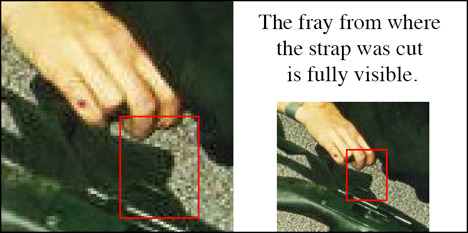
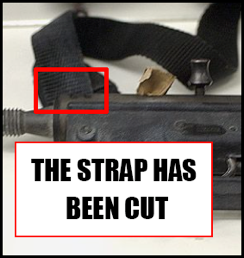
Investigators cut the TEC-DC9M strap to remove the pistol from Klebold’s body. They didn’t remove the entire strap - that’s why the strap is still visible over Klebold’s body, around his waist, and underneath his palm.
What you see in the leaked photo is Klebold’s empty hand after the pistol was removed along with the frayed, cut end of the TEC-DC9M strap.
His hand is resting over the part of the strap that was left behind when the pistol was cut off of his body.
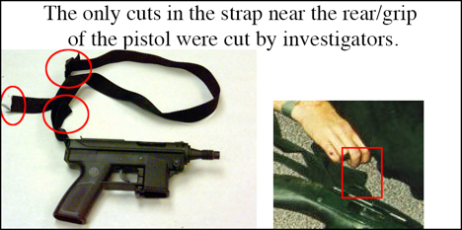
Prior to investigators cutting the strap, there were no ‘loose ends’ or cut pieces of the strap other than where the buckle was located. The loose end by the buckle is extremely short, perhaps 20mm long by a casual estimate. The loose end by the sling mount is longer, but it’s not long enough to be next to Klebold’s hand.
The cut piece of strap visible in the leaked photo is much longer than the end piece sticking out of the buckle. Investigators only cut off about 25 inches of strap; just enough to remove the pistol.
The cut piece of strap coming out from underneath Klebold’s hand can only be from one of the cuts investigators made to remove the TEC-DC9M pistol from Klebold’s body.
The cut strap under Klebold's hand is not from the Hi-Point rifle
The rifle strap was not cut at any time and it's visibly intact in the leaked photos.
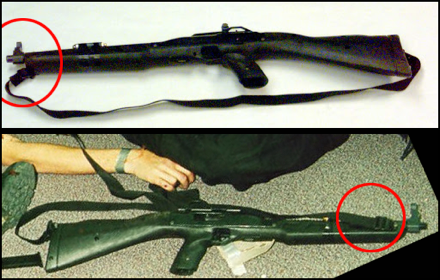
The only portion of the rifle strap that has a loose end is the excess from the end of the strap fed through the buckle located at the front of the barrel.
Notice the loose end of the rifle strap (by the barrel) is nowhere near Klebold’s hand.
The cut strap visible in the leaked photo is the TEC-DC9M strap, cut by investigators to remove the pistol from his body.
Still not convinced there is no pistol in the leaked crime scene photo? Let’s look at a few more points:
Some people say, “You can see the end of the grip/magazine sticking out of Klebold’s hand!”
I’ve said this, too. I knew it could not be the grip and presumed it was the magazine. I was wrong. It’s not any part of the pistol - it’s the strap.
When you look at the photo already believing there is a pistol hidden under his leg, it’s natural to conclude the black “something” sticking out of Klebold’s hand must be the grip or magazine of the pistol. However, it’s actually the strap. There are 2 ways we know it’s the strap. In addition to the visible cut piece of the strap indicating the pistol has already been removed, adjusting the image reveals the texture is a cloth-like material and not a solid material like metal.
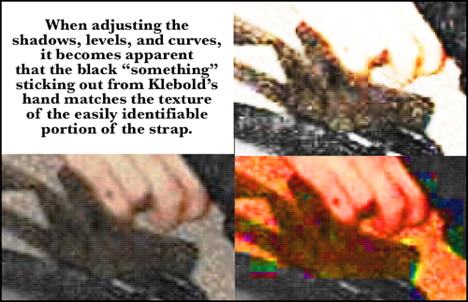
Another point to consider is the TEC-DC9M grip only accommodates 3 fingers. Klebold cannot have four fingers curved over the grip of the pistol AND have the grip stick out of his hand AND have the trigger box and magazine well entirely concealed under his leg. The dimensions of the pistol make that impossible. The grip is too short.
If the grip were visibly sticking out of his hand by his pinky finger, then his pointer finger would be directly over the trigger box and would be unable to curl. The trigger box would prevent his index finger from curling. Also, we would see the trigger box and magazine well.
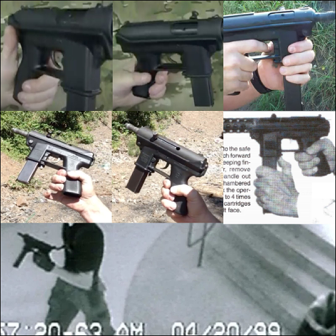
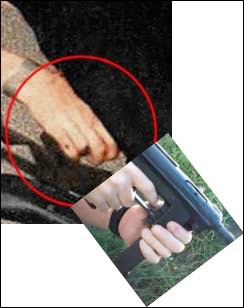
Here’s another view of the strap with adjusted contrast that shows the texture of the black “something” matches the portion of the strap we can see clearly.
There’s something else to note about this photo. People have speculated that the round “bumps” in Klebold’s pants are part of the pistol underneath his leg. The “bump” closest to his hand is perceived to be the magazine well.
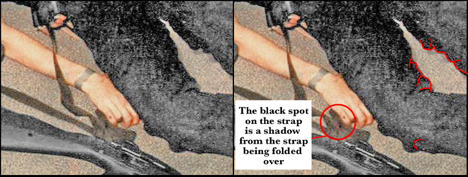
Notice that the contrast enhances the folds of Klebold’s pants and you can see that the “bumps” are created from creases in his pants. The same type of creases with “bumps” can also be seen on the inside of his left leg.
Adjusting the contrast reveals the texture of the “bumps” to be Klebold’s pants, not the magazine well.
Also, you can see a small shadow where the strap is folded over as it comes out from Klebold’s hand.

If the “bumps” were portions of the pistol under Klebold’s leg, the spacing wouldn’t match the spacing between the grip and the magazine well.
The first “bump” is too close to his fingers and the second “bump” is too far away to be the magazine well.
Also, the trigger box and magazine well would be visible next to his leg above the horizontal red line.
Still not convinced? Perhaps you might be thinking okay, the strap is under his hand, but the pistol has to be under his hand, too.
Remember, a long, frayed, cut end of the strap is clearly visible in the photo. However, there are more reasons why the pistol cannot be underneath Klebold’s leg in the leaked photo.
First, remember that the TEC-DC9M was cut off Klebold's body hours before the leaked photos were taken.

Investigators removed the pistol from Klebold’s body at 3:35 p.m. on April 21, 1999.
The pistol was removed hours before the other three firearms were removed from the scene.
Since the optical illusion is so strong, let's keep going.
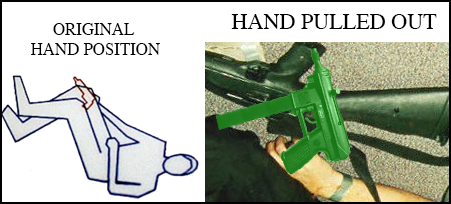
The crime scene diagram (left) shows the orientation of the pistol as it was found underneath Klebold’s leg.
The image overlay (right) shows what the pistol would look like if there was a pistol in the leaked photo.
If the pistol were in Klebold’s hand in the photo, it would be in his hand in the orientation in which it was found and it would overlap with the Hi-Point rifle (either over or under) and would be clearly visible. It's not.
The pistol was found underneath Klebold’s leg - not out in the open. The only reason his hand is out in the open is because investigators pulled it out to remove the pistol.
There is no pistol in the leaked photo.
Now let’s get back to the magazine that was found in the pistol.
The magazine found in the pistol is JCSO evidence #1093. This is the final piece of evidence that unravels the entire theory that the pistol was found without a magazine.
In order to arrive at the conclusion that the pistol was found without a magazine, you must disregard documented evidence and adopt the position that a baseless theory with no supporting evidence is correct and multiple pieces of documented evidence are wrong.
For example, you must disregard documented evidence and believe:
1. The documented evidence stating the pistol was found with a loaded magazine is wrong.
2. The documented orientation of the pistol in the crime scene diagrams - from the initial sketch to the final computerized diagram - are all wrong.
3. The documented evidence stating evidence #1093 (magazine w/live rounds) was found in the pistol is wrong.
4. That Tom Griffin (CBI) incorrectly instructed the sketch artist, Laura DeLong, on how to position the pistol.
5. And you must also believe that the sketch artists’s supervisors approved a multitude of edited diagrams for 7+ months straight with the pistol in the “wrong” position each time, made detail-oriented corrections for other pieces of evidence and never made any corrections to the pistol’s position.
Based on the documented evidence, it makes more sense to consider that the perception of the leaked photos is incorrect.
Item #1093 is the magazine found inside the TEC-DC9M
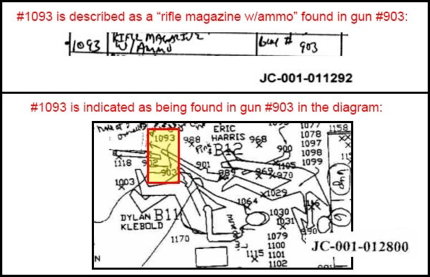
In Evidence Volume I, p.11292, item #1093 is described as a “rifle magazine w/ammo” found in gun #903 (the TEC-DC9M). The same description is found in Evidence Volume II, CBI Reports on page 12042.
This is an instance where a true mistake was made in the documentation. The magazine was initially incorrectly documented as a “rifle” magazine. However, that mistake was corrected and resolved on p.12688 from Library Team Two. [Credits go to Redditor WillowTree360 for finding this correction]
How do we know item #1093 was found INSIDE the pistol?
In Library Team Two, p.12800, a line is drawn from item #1093 to gun #903 (TEC-DC9M) to indicate that’s where item #1093 was found. You can also see the location of where the item was found is listed as “gun #903” in Evidence Volume I p.11292.

The evidence number was written on the diagram on the other side of the Hi-Point rifle, but it was found in the TEC-DC9M. Why was this done?
The sketch artist, Laura DeLong, noted that she stacked evidence numbers around the shooters’ bodies because of space constraints.
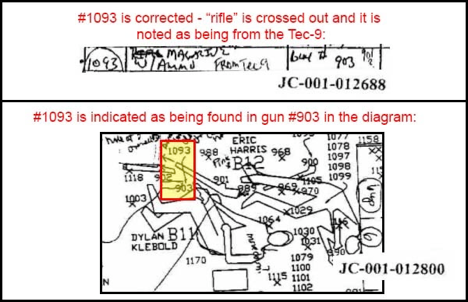
Here is the documentation where item #1093 was corrected as being from the TEC-DC9M on p.12688 from the Library Team Two report.
The word “rifle” is crossed out and it’s noted that the magazine came “from the Tec 9.”
A note in the margin says, “901?” Gun #901 was the Hi-Point rifle. This note was likely added because the magazine was initially documented as a “rifle” magazine. However, in the end, it was specifically corrected as being found “from” the “Tec 9.”
Item #1093 is the magazine that was found inserted into the TEC-DC9M.
Misinterpretation #4: The crime scene diagrams and sketches don’t depict a magazine. If the pistol were found with a magazine, the sketch artist (Laura DeLong) would have drawn the magazine.
Evidence-based truth: The diagrams are intentionally simple and plenty of details are absent.
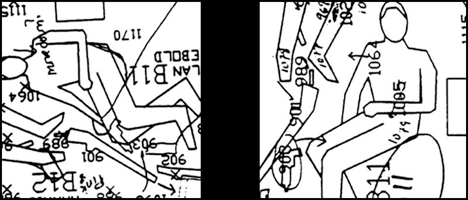
Why don’t the crime scene diagrams depict a magazine inserted into the TEC-DC9M if that’s how it was found?
This is a great question with a simple answer. If you take a closer look, you’ll find that none of the firearms are depicted with any level of specificity.
Let’s look at some firearms-related details not depicted in the diagrams.
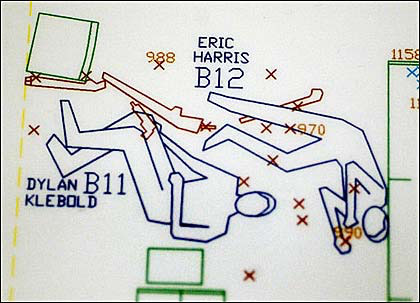
The crime scene diagram omits the following firearms details:
- Harris’ shotgun has no trigger (we know it had a trigger)
- There is no strap depicted on the Hi-Point carbine rifle (we know it had a strap)
- There is no strap depicted on the TEC-DC9M pistol (we know it had a strap)
- There is no strap around Klebold’s body (we know the strap was around his body)
- Klebold’s shotgun is depicted as an elongated rectangle with a closed action (it was found with an open action)
- The diagram is also missing the gloves on Klebold’s left hand/Harris’ right hand, Klebold’s hat, the crickets recovered from the floor, various ammo pouches, their belts, Harris’ suspenders, and more.
The diagrams are not intended to be a detailed depiction of the scene. Firearms are routinely drawn as a general shape, as is clearly the case with all four firearms in the diagram, not just the TEC-DC9M.
The absence of a magazine in the diagram is a reflection of the simplicity of the diagram; it is not a reflection of the absence of a magazine when the pistol was found.
Still not convinced? Let’s look at how the crime scene was sketched on April 21, 1999.
The sketch artist, detective Laura DeLong (Arapahoe County), arrived on the scene at 1349 hours [Source: Evidence Vault Documents p.16094] and began sketching the scene at 1647 hours - 1 hour and 13 minutes after the pistol was removed from Klebold’s body at 1535 hours. The pistol was removed by detective Alan Hammond (CBI) and detective Tom Griffin (CBI) under the direction of Triena Harper (JCSO coroner). [Source: Library Team 2, p.12653]
Since the pistol had already been removed from Klebold’s hand when DeLong drew the sketches, how did she know the pistol was underneath Klebold’s leg? How did she know his hand was hidden? How did she know the orientation of the pistol?
Some speculate that she simply guessed at the pistol’s orientation and position. However, that’s not true. Tom Griffin (CBI) told her how and where to place the pistol. He removed the pistol from Klebold's body and knew exactly how it was positioned.
DeLong created the initial sketch at the scene and then coordinated with other investigators, including Tom Griffin (CBI) and her supervisor, Tom Adair, to refine the accuracy of evidence. DeLong used more than 1,200 photographs, field notes from other investigators, and conversations with other investigators to refine the placement of 279 pieces of evidence. [Source: Library Team 2, p.12244]
DeLong was still refining the diagrams as of November 17, 1999 - seven months after the shooting.
Still not convinced that the sketch artist placed the position of the TEC-DC9M pistol under Klebold’s leg because she was told that’s where it was found directly by investigators who removed the pistol? Here’s more proof.
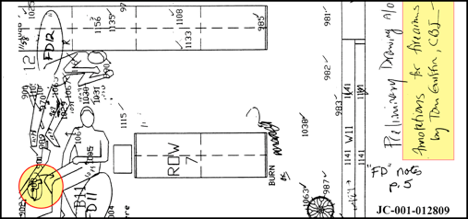
This diagram specifically notes “Annotations for firearms by Tom Griffin, CBI.”
The annotation here for the TEC-DC9M is an arrow pointing underneath Klebold’s leg. Tom Griffin was one of the investigators who removed the pistol from Klebold’s body. He had first hand knowledge of where and how the pistol was found.

Throughout the investigation, DeLong submitted updated versions of the diagrams to Tom Griffin for review. No changes were made to the position of the pistol at any time. It was already documented correctly.
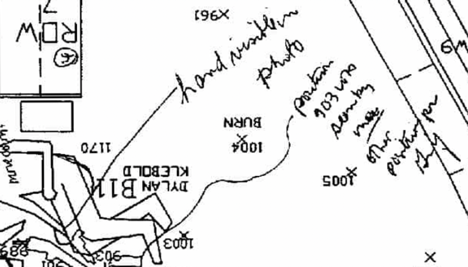
This edited version of the diagram now depicts Klebold’s hand and pistol concealed underneath his leg, as he was found. At first, DeLong drew the pistol away from Klebold’s leg and Tom Griffin made a note on the diagram that the pistol was found underneath Klebold’s leg. DeLong corrected the position and intentionally placed the pistol under Klebold’s leg per his instruction.
DeLong’s notes indicate that:
1. Klebold’s hand is visible in the photo (“hand visible in photo”)
2. The position of the TEC-DC9M as depicted in the diagram was seen by [illegible] (“position 903 seen by ____”) Possibly "me"
3. “Other position per Grif.”
DeLong noted that Klebold’s hand is visible in the photo because the photos she was given to verify the scene were taken after the pistol was removed from Klebold’s body. In her diagram revisions, she placed the pistol under Klebold’s leg per Tom Griffin’s instruction and made a note about the discrepancy regarding what she saw in the photos vs. how Griffin instructed her to draw the pistol.
Throughout the entire process, DeLong submitted her diagrams with changes to Griffin and Adair for feedback. DeLong made many changes based on their feedback. [Source: CBI, p.12642, p.12654] However, no corrections were ever made to the pistol’s position.
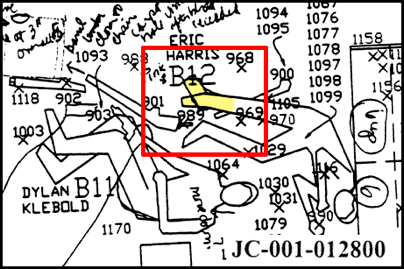
DeLong made numerous, detailed corrections to the diagrams based on feedback from Tom Adair and Tom Griffin. One of those detailed corrections was rotating Harris’ right foot.
DeLong revised the placement of evidence and body positions for months, adjusting slight angles. The orientation of the pistol was not overlooked and transposed.
The pistol was intentionally positioned as it is seen in the diagrams; Tom Griffin instructed DeLong to draw it in that exact position because that’s how it was found.
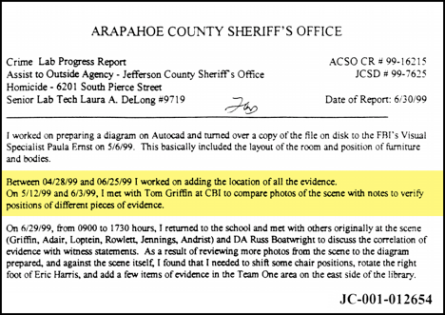
DeLong compared more than 1,200 photos of the crime scene with notes made by multiple investigators and made corrections to refine the accuracy of evidence for more than seven months. Once Tom Griffin (who saw the pistol himself) noted where/how the pistol was found, and DeLong updated her sketch/diagram to reflect the proper position, the position of the TEC-DC9M pistol was left unchanged.
This means the final diagrams we have are correct. The pistol was found under Klebold's leg upside-down with his fingers lightly curved over the grip.

More of DeLong’s notes indicating she was checking with Hammond and Griffin on the placement of evidence. She didn't just position the pistol randomly, and it wasn't guesswork.
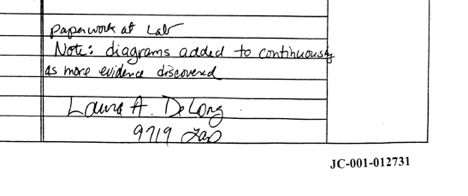
DeLong’s notes read, “Note: diagrams added to continuously as more evidence discovered.”
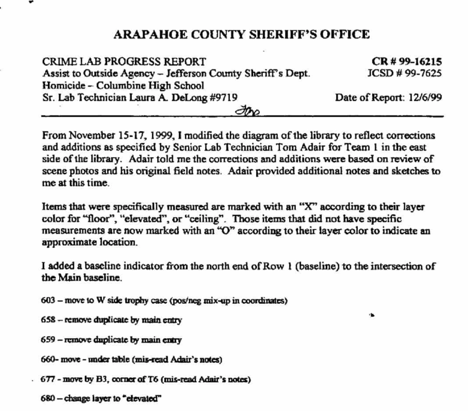
Some examples of details DeLong refined over time based on feedback from her supervisor, Tom Adair, who provided her with additional notes and sketches regarding the scene.

This letter from DeLong documents that her supervisor, Tom Adair, specified changes for one of her drawings after comparing it to photographs.
The original crime scene sketch

This is the original crime scene sketch [Source: Library Team 2 p.12757]. In the upper right corner, DeLong notes:
“Video shows chair @ feet of B11 by 903.”
B11=Body 11=Klebold
903=TEC-DC9M pistol
DeLong drew the original crime scene based on photos and video taken during the initial walkthrough along with notes provided by her supervisor and other investigators, including Tom Griffin, who helped remove the pistol from Klebold’s body.
Why do people think the pistol was found in an orientation opposite from the diagrams?
The diagrams aren’t wrong. The perception of the leaked photo is wrong. Here’s what’s going on.
1. They know Klebold was found with the grip of the TEC-DC9M pistol under his fingers.
2. They assume the leaked photos depict the original scene, there's something dark under Klebold's hand, therefore, they conclude “the pistol has to be somewhere in the photo.”
3. They assume Klebold’s hand is over the grip in the orientation that would be a firing position, which leads to the conclusion that the receiver portion of the pistol must be hidden under his leg.
4. They know the pistol was documented as being found with a loaded magazine, but…
5. The pistol and magazine aren’t visible in the leaked photos.
6. Given the existing misperception of the orientation of the pistol, since the magazine isn’t visible, the conclusion is “the diagrams and documented evidence are all wrong.”
7. In reality, the pistol was found with the magazine between Klebold’s legs, pointing toward his left leg and in the leaked photos the pistol has already been removed from his body.
One misperception builds additional misperceptions, which causes some people to dismiss documented evidence and declare diagrams to be incorrect in order to support the original misperception that the there is a pistol in the leaked photos. However, there is no pistol in the leaked photos.
To recap, here’s what the documented evidence tells us
1. The TEC-DC9M fired the fatal shot —-> 1-1/2” of drawback in the pistol matched Klebold’s DNA
2. The TEC-DC9M was found with a loaded magazine —-> JCSO evidence #1093
3. The TEC-DC9M was found under Klebold’s fingers upside-down —-> All crime scene sketches and computerized diagrams display this orientation
4. Klebold was not found gripping the pistol; Klebold’s right fingers were “slightly curved” over the pistol (likely from rigor mortis and not because he was ever gripping the gun) —-> Detective Jennings’ documentation
5. The leaked crime scene photos were taken after two bomb sweeps and after the TEC-DC9M was removed from Klebold’s body (and 3/4 weapons have been moved) —-> Comparing the leaked photo to a pre-bomb sweep photo establishes this fact
6. The strap has been visibly cut in the leaked photo —-> Investigators cut the strap to remove the pistol
7. There is no TEC-DC9M in the leaked photos —-> It’s an optical illusion, it's the strap under his fingers
The only question remains… could Klebold have shot himself with the TEC-DC9M, using his left hand, and grabbed at the pistol with his right hand after he fell to the floor? It’s possible, but if he shot himself, it's more likely that he used two hands.
Why was the TEC-DC9M removed before the other guns?
The leaked crime scene photos depict the scene after the pistol has been removed from Klebold’s body while all other firearms had yet to be removed.
You might be wondering why investigators would take photos after removing the TEC-DC9M, but leave the other firearms on the scene.
I was talking with a Reddit user named SkipperWman who made a great point that might explain this. Since the TEC-9 models were so easy to convert to fully automatic, investigators may have recognized the potential danger when they saw the TEC-DC9M. On a converted TEC-9, one pull of the trigger (and possibly an accidental bump) can empty an entire magazine.
Considering the potential for extreme danger, it makes sense that investigators would remove and secure the pistol as quickly as possible, before the other firearms and continue processing the scene.
[Source: CBI; Crime Scene Report Team Two, p.302]
As discussed earlier, in the leaked photos, the Hi-Point rifle has been moved from its original position. Why would investigators move the rifle?
The rifle’s original position would have been in the way of removing the TEC-DC9M. Investigators may have temporarily removed the rifle to access and secure the TEC-DC9M, and then placed the rifle back in the same general area to continue processing the scene. Or, they may have just cleared the chamber, which is routine.
Where did the leaked crime scene photos come from?
Photo roll #8 is the only photo roll log that lists overall photos of the shooters' bodies that matches the leaked photos, other than photos from the initial walkthrough (rolls #1&2).
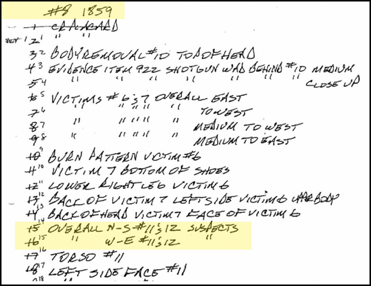
Roll #1 from the initial walkthrough lists the same type of overall photos. However, since roll #1 is from the initial walkthrough, the photos would depict a different scene: Klebold’s hand and pistol would be under his leg and the pistol’s magazine would be visible between his legs pointing toward his left leg.
Roll #8 was taken at 6:58 p.m., which is 4 hours and 23 minutes after the pistol was removed from Klebold’s body. If the leaked photos were taken at 1859 hours, then there cannot be a pistol in the photo since it would have been removed almost four-and-a-half hours prior.
Since photo roll #8 was taken at 1859 hours, we know for a fact that there are overall photos of the shooters after the pistol was removed from Klebold’s body. We don’t know for sure if those are the leaked photos. However, we know for certain such photos do exist.
However, since there are no other overall photos of the shooters bodies in the list of photos aside from photos on Roll #1 from the initial walkthrough [Source: Library Team Two p.12330], and there is no pistol in the leaked photos, the leaked photos are most likely from Roll #8, taken 4 hours and 23 minutes after investigators removed the pistol from Klebold’s body.
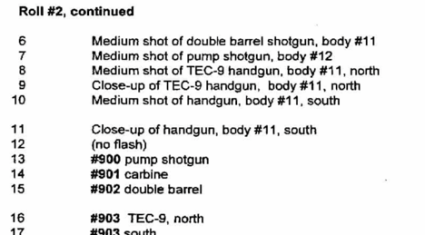
Looking at the photo log for roll #2, which was also taken during the initial walkthrough, we find closeups of the pistol listed. A closeup of the pistol could only have been taken after pulling the pistol out from underneath Klebold’s leg.
This means that right after the initial walkthrough, and long before investigators got to roll #8, Klebold’s hand and pistol had already been pulled out from underneath his leg where the pistol was photographed close-up, before being removed at 3:35 p.m. (1535 hours).
Since closeups of the pistol were taken on Roll #2, then photos taken on Rolls #3+ would depict a scene without a pistol.
How do we know the photo rolls were taken in sequential order?
Photo log timestamps
The hand-written photo logs have time stamps and begin on page 295 from the CBI Crime Scene Report Team Two document. Rolls 1&2 do not have timestamps. However, subsequent rolls are time stamped as follows:
- Roll #3: 3:43pm
- Roll #4: 3:55pm
- Roll #5: (no time stamp)
- Roll #6: 5:00pm
- Roll #7: 5:20pm
- Roll #8: 6:59pm
- Roll #9: 7:22pm
- Roll #10: 7:42pm
- Roll #11: 8:00pm
- Roll #12: 9:45pm
- Roll #13 begins the next morning on April 22, 1999.
[Source: CBI; Crime Scene Report Team Two, p.295-304]
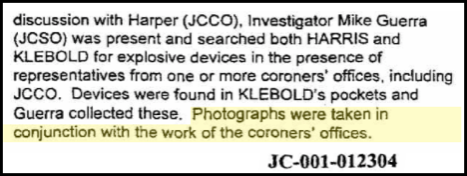
The library documents provide another clue about the origin of the photos.
“Photographs were taken in conjunction with the work of the coroners’ offices.”
[Source: Library Team Two p.12304]
“At 3:35 p.m. under the direction of Jefferson County Coroner’s Office Chief Deputy Coroner Triena Harper, Hammond and Griffin cut the strap of this firearm and removed it from Klebold’s right hand.” [Source: Library Team Two p.12302]
Since the leaked photos were taken after the TEC-DC9M was removed from Klebold’s body, and before the other firearms were removed, and the coroner directed the removal of the pistol, it’s likely that the leaked photos were “taken in conjunction with the work of the coroners’ offices."
Point #5: Eric Harris Died First
Those who believe Harris killed Klebold are missing some important clues in the leaked photos that indicate Harris died first.
When Klebold died, he landed with the right side of his face on Harris’ left leg just below the knee. This is supported by the photos and the documented evidence.
From Klebold’s autopsy report, we know he rested on the right side of his face briefly - just long enough to allow some blood to flow out of his exit wound and across his face.
After a brief time, Klebold rolled over onto his back and aspirated blood before he died. He was not pushed over by investigators looking for bombs. He rolled over while he was still alive.
“Some of the blood flows on the face were also formed with the head in a position other than as found. These flows were consistent with KLEBOLD’S head resting on the right side of the face to allow the blood flow on the left side out of the wound.”
[Source: Klebold’s autopsy report & Library Team 2 p.12321]
How do we know Klebold fell on Harris’ leg and not on the floor before Harris committed suicide?
The bloodstain patterns on Harris’ left leg indicate that when Klebold fell, he landed with the right side of his face on Harris’ left leg. I’ll show you how.
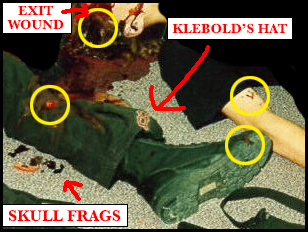
Ideally, we’d have the DNA test results from Eric’s pants to know for certain, but we don’t have that information. So, how do we know Klebold fell onto Harris’ leg and not somewhere else? How do we know the blood on Harris' pants came from Klebold?
In summary, it’s mainly the impact splatter and flow patterns down Harris’ pant leg creases.
How do we know Klebold fell onto Harris’ leg and not somewhere else?
- Harris’ left pant leg is blood-soaked with a visible concentration of blood in the middle. If you rolled Klebold back onto Harris’ leg, the darkest spot of blood would line up with Klebold’s exit wound. (yellow circles)
- Klebold’s skull fragments landed on the inside of Harris’ left leg, while his hat landed on the outer side of Harris’ left leg. No skull fragments, bloodstains, or blood splatter/spatter from Klebold were found under Harris’ leg or body. Harris’ left leg was already on the floor when Klebold was shot and fell. When you look at the scene after Harris’ body was removed, you can see the void, which proves this. I’ll explain what a “void” is shortly.
- If you rolled Klebold back onto Harris’ leg, the blood transfer on Klebold’s right bicep (yellow circle) would line up with the blood on Harris’ left boot (yellow circle). Most likely, the blood was on Harris' boot and transferred to Klebold's bicep when he fell on Harris' leg.
- Harris’ left pant leg appears to have had weight resting on it when it became blood-soaked; the fabric is pushed in at exactly the point where Klebold’s face would have been pressed into Harris’ leg. Becoming blood-soaked after pressure is applied to the pant leg would cause the pant leg to stiffen and remain crumpled inward as seen in the photo.
- The blood on Harris’ leg is not spatter or splatter. First, it’s too low to be back spatter from shooting one of his victims. Harris’ pant leg could not have become blood-soaked from back spatter. The flow patterns indicate the blood came from a flowing source, which would have been Klebold's exit wound.
#1: Harris’ left pant leg is blood-soaked with a visible concentration of blood in the middle.
If you rolled Klebold back onto Harris’ leg, the darkest spot of blood would line up with Klebold’s exit wound.
When blood flowed out of Klebold’s exit wound (right temple), the right side of his face was on Harris’ left leg. The bright spot that shows a concentration of blood is where Klebold’s exit wound was pressed against Harris’ leg. When the blood flowed out of Klebold’s exit wound, it did two things.
[1] The blood soaked through Harris’ pants in the immediate area of the exit wound.
[2] Once the flow of blood moved past where Klebold’s head was pressed against Harris’ leg, the blood flowed toward the ground according to the laws of physics - over and down Harris’ pant leg via the creases in the fabric - the paths of least resistance. You can see the blood-filled creases are the only areas where blood is concentrated which means it came from a flowing source.
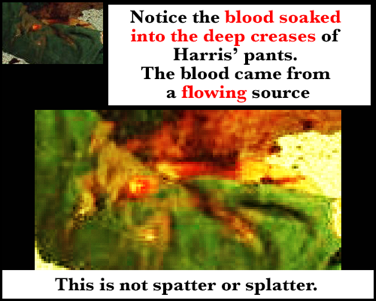
In this image, I’ve adjusted the levels and contrast of the photo. This adjustment reveals the flow patterns through the creases of Harris’ pants even more clearly.
Notice the blood is heavily concentrated toward the top (where Klebold’s face would be if you rolled him over onto Harris’ leg) and the remainder of Harris’ pant leg shows blood only filling the creases of his pants in a flow pattern - not a spatter or splatter pattern.
The blood on Harris’ pants came from Klebold's exit wound
First, let's establish that the blood and brain matter on Harris' leg matches Klebold's DNA:
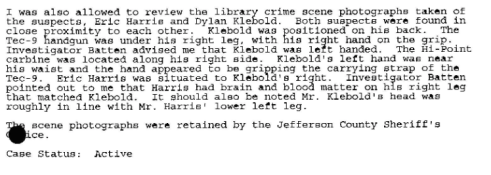
Source: El Paso, Case Core, p.01-405
It says "right" leg, but I think that's a typo or the investigator writing the summary transposed R/L in his mind when writing this.
This means Harris died first and Klebold landed on his leg. The photos make this obvious, but here we have lead investigator, Kate Battan, acknowledging this as a laboratory-tested fact.
Forward spatter comes from an exit wound and back spatter comes from an entrance wound. Forward spatter is generally a fine mist, while back spatter consists of fewer, larger drops. Splatter is larger than spatter.
However, what you see on Harris’ pants is not forward spatter or back spatter. It is not from a victim, either.
Back spatter travels back toward a firearm from an entrance wound. Harris shot people at close range while he was standing or crouched down. His gun would have been angled down at his victims or level with his chest when crouching. If he fired one of his guns at shin-level, the length of his firearms would necessitate that firearm to be between his legs or on the outside of his right leg since he was right handed. The amount of blood seen on Harris’ pants would not land on Harris’ left shin area from shooting someone with his rifle or shotgun positioned in that manner.
Back spatter travels backwards from an entrance wound, up the same trajectory as the bullet, toward the firearm. The only way for back spatter to land on Harris’ left shin area is if he shot someone with his firearm low to the ground at shin-level while holding the gun more toward his left side. Harris was right handed, which would make shooting from that position unlikely. Even so, this isn't back spatter.
#2: Klebold’s skull fragments are on the inside of Harris’ left leg, while his hat landed on the outer side of Harris’ left leg. No skull fragments or blood splatter from Klebold were found under Harris’ leg or body. Harris’ left leg was already on the floor when Klebold was shot and fell.
If Klebold died first, Harris’ left leg wouldn’t be tightly surrounded by Klebold’s skull fragments on the inside and Klebold’s hat on the outside. Harris’ left leg was already on the floor when Klebold died. That’s why the skull fragments are on one side and the hat is on the other side and there was nothing under Harris’ body. This is part of the void pattern that proves Harris died first.
If Harris shot Klebold, there would be blood on the carpet directly under Harris’ left leg from when Klebold rested on the right side of his face when blood flowed out of his exit wound. There was no blood - no pools of blood, and no spatter or splatter under Harris’ leg. All blood, brain matter, and skull fragments were solely located between, on and around Harris’ left leg, which means Harris’ left leg was present on the floor when Klebold died.
Now let’s talk about the “void"
Earlier, it was explained that the absence of evidence is not, itself, evidence. Based on the common perception of the word “void,” it’s easy to think a void is the absence of evidence. It is not.
A void is a bloodstain pattern where the path of the blood has been partially obstructed by an object or person. For example, if there is a beam in front of a wall and blood is directed at that wall, the blood will land on the wall on either side of the beam. The beam will block the path of the blood. If the beam is removed from the scene, the pattern on the wall would show that something was obstructing the path of the blood.
So, while a void includes the absence of blood, a void is a bloodstain pattern.
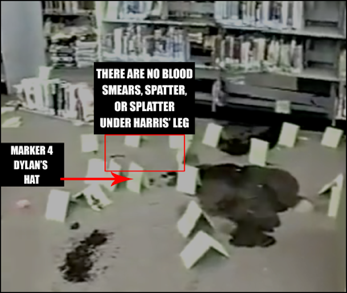
What are the bloodstains in the image above?
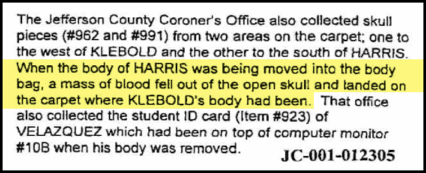
The image above with the bloodstains is from the tape dubbed the “Fire Department Training Video” and shows the scene after the shooters’ bodies have been removed. The large pool of blood on the right is from Klebold. The smaller bloodstain toward the left bottom corner came from Harris’ body. The blood spilled out of Harris’ head when they moved him into the body bag. [Again, my apologies for not having the page number for the documentation below.]

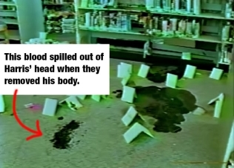
The bloodstain on the carpet where Klebold’s right leg was, noted in the photo (left) spilled out of Harris’ skull when they moved his body.
More about the bloodstains:
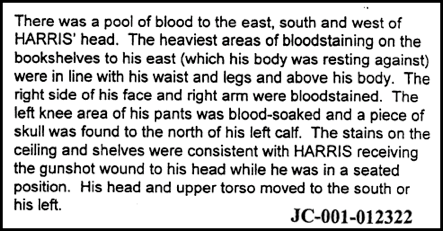
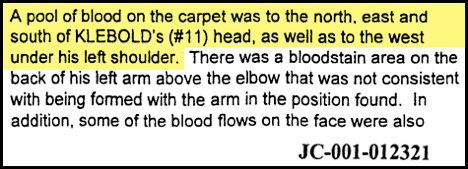
The documentation from Library Team 2 describes the presence of blood, tissue, and skull fragments on and around the bodies, including on the bookshelf behind Harris’ body.
Notice that investigators documented that the pool of blood coming from Klebold’s head was also under his left shoulder. Next, notice that no blood was documented under Harris’ body. Not because investigators left it out - there really was no blood under Harris’ leg/body.
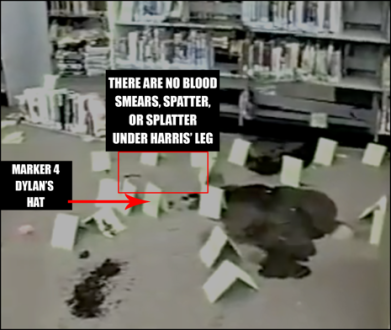

The red circle in the photo above is where Klebold fell onto Harris’ left leg.
The red rectangle in the photo below is the area where Harris’ left leg was before his body was removed.

The red circle in the photo below is the area where Klebold rested on the right side of his face on Harris’ leg. It’s a different perspective of the scene.

A void pattern exists when something (a person/object) blocks the path of traveling blood. In this scene, Harris’ left leg blocked the path of the blood, brain matter, and skull fragments projected from Klebold’s exit wound. That’s why Klebold’s skull fragments ended up on the inside of Harris’ left leg, while his hat ended up on the outside of Harris’ left leg, and no blood, brain matter, or skull fragments ended up in the area underneath Harris’ leg. Harris’ leg was already on the carpet when Klebold was shot.
If Klebold was shot before Harris committed suicide, he would have fallen onto the right side of his face, on the carpet, UNDER the area where Harris’ left leg is in the leaked photo. This would have resulted in blood on the carpet under Harris’ leg.
As you can see, there is no blood on the carpet in the area where Harris’ left leg was. The only place where blood exists on the carpet in that general area is on the outside of where Harris’ left leg was. This makes sense considering blood flowed out of Klebold’s exit wound down Harris’ pants at that exact location while the right side of his face rested on Harris’ left leg.
Now there’s another important question.
Could Klebold have died first and landed on Harris’ leg before Harris committed suicide?
Maybe.
First, we know Harris was seated on the floor or squatting low when he died. However, the shotgun was found under Harris’ right leg, which indicates Harris was seated on the floor with his legs bent to create space for the shotgun recoil to force it under his leg. If Harris’ legs were stretched out flat on the ground when he shot himself, his shotgun would not have ended up underneath his right leg.
If Harris’ legs were bent in front of him like in the photo below, it would not have been possible for Klebold to land on Harris’ leg.
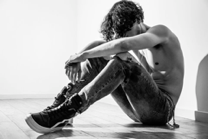
Look closely at Harris’ left leg in the leaked photo. His foot is turned outward. This means the area where Klebold’s face rested on Harris’ leg was the INSIDE of Harris’ calf. For Klebold to have landed on the inside of Harris’ leg, Harris’ leg would have needed to be extended outward on the floor. That's the only way the inside of his leg would be exposed.
Try it yourself. Sit on the floor and turn your right foot outward and see how that places the inside of your leg facing up.
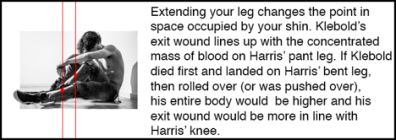
Even if Klebold did manage to land on Harris’ bent leg at an angle, and then roll over onto his back, there’s another dilemma. When Harris’ leg extended outward, that would have moved the spatial point of impact further down. If that were the case, we wouldn’t see Klebold’s exit wound and blood transfer on his bicep line up with Harris’ body.
In other words, the point in space occupied by the area on Harris’ leg where Klebold landed would have shifted forward when Harris extended his leg. When shifted, it would no longer line up with Klebold’s exit wound.
Klebold could not have landed with his bicep on the inner toe of Harris’ left boot if Harris’ legs were bent with his feet on the floor.
Klebold could not have landed with the right side of his face on the inside of Harris’ left lower leg if Harris’ legs were bent.
Now there’s another question. How do we know Harris wasn’t sitting with his legs extended, Klebold killed himself, fell onto Harris’ leg, Harris rolled him over, and then Harris bent his legs and committed suicide while still seated in the same spot?
The force from the shotgun blast would have moved Harris’ body, causing a misalignment with Klebold. This is unlikely. Also, Harris would have had to fire Klebold's TEC while it was attached to his body (awkward) and the shot would have been fired toward Harris' own body. He was suicidal, but even so, doing that wouldn't make sense.
There was a bloodstain on the back of Klebold’s left arm that wasn’t consistent with how he was found. That bloodstain (see photo below) could have come from Harris pushing Klebold off of his body. However, we don’t have any DNA reports for that bloodstain to determine where it came from.

Point #6: Klebold's body was not moved to look for bombs
Myth: In the leaked crime scene photos, Klebold is on his back because they moved him during the bomb sweep.
Evidence-based truth: The bomb technicians were specifically instructed not to move the shooters' bodies while searching for and collecting bombs. At least two bomb sweeps were done before their bodies were moved to retrieve the remainder of IEDs from their inaccessible pockets.
“The sweep was done to determine if there were any additional live IEDs (with the exception of any more that would be found on the bodies of KLEBOLD and HARRIS, which had not been moved at this time). [Source: 11k, p.7811]
The coroner said Klebold was capable of some involuntary movement after the bullet went through his head, so it's possible he rolled over on his own. We know he was only resting on Harris' leg briefly because otherwise, there would be more blood on Harris' leg and the pool of blood under Klebold's head would be much smaller. The size of these bloodstains would be reversed and the larger pool would be on Harris' leg.
Point #7: Who Lit the Final Molotov Cocktail?
A molotov cocktail was found on table #15 near Harris and Klebold's bodies. It had not been thrown, but the glass burst. We know Harris died before the glass burst because his brain matter was adhered to the table underneath the oily substance. It's said that Klebold lit this final molotov, but unfortunately, there's no way to know who lit the device. All we can know is that the glass burst before Harris died, which means Harris could have lit the molotov as easily as Klebold.
Investigators concluded the cocktail was set on the table, lit, and left to burn until the glass burst, which would have taken a long time. If they made traditional molotovs, this would make sense, but that's not the case. Their molotov cocktails were not designed to be thrown. All of their molotovs were made with crickets taped to the side with a long fuse, and the cricket explosion would break the glass.
We can discern from the photo below that their fuses were about 15" long. They used Visco that burned at a rate of one inch per second, so we can guess that their fuses had a time delay of about 15 seconds.

If the molotov on table #15 had a 15" long fuse, and Harris lit it, he was dead within 15 seconds. However, since Klebold died last, if he lit the molotov, there's no way to know when he lit the fuse. He could have lit it before Harris died, or after. Either way, we can't determine who lit the molotov.
Point #8: Harris' DNA was found on the trigger area of the TEC-DC9M
Blood matching Harris' DNA was found on the trigger area (23B) of the TEC-DC9M.
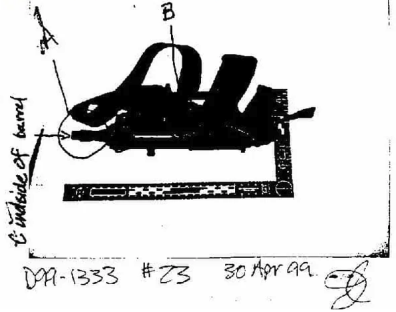

[Source: CBI, DNA reports, p.6 & Evidence Volume II, p.12137]
The tendency is to assume this means Eric pulled the trigger, but the evidence doesn’t support Eric dying second, and the blood wasn't found on the trigger - just in the general area.
It's possible that they used each other's guns. There's no reason to believe they didn't. Harris can be seen shooting the TEC at Rampart Range. It's also possible that Klebold touched something that had Harris' blood on it from when Harris broke his nose and was bleeding.
Note: It's safe to assume Harris did break his nose when his shotgun recoiled in his face after shooting Cassie Bernall because Evan Todd told investigators Harris' nose was pushed off to the side and looked broken.
Final Questions
Q: Why did Klebold have a bruise on the apex of his head?

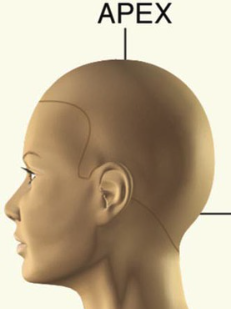
A contusion (bruise) can only be formed while someone is alive. It wouldn’t make sense that Klebold bruised the apex of his head when falling onto Harris' leg since he fell on the right side of his face and that would have absorbed the impact. It wouldn't have been from rolling over onto his back, either. However, one witness saw Klebold trip and fall during the shooting, so that is a possibility.
Some people speculate a cop may have hit him over the head with a flashlight before executing him. However, this is just speculation and it's impossible to know what caused this contusion.
Q: Why did investigators cut Harris’ pants off completely and remove them at the scene?
There is no available documented evidence that describes when and why Harris’ pants were cut off of his body. We know his pants were cut off because they are listed in the evidence as having been cut off, and his body was delivered to the medical examiner’s office without pants.
The most logical reason would have been to preserve the evidence on his pants. I've never found his pants in the evidence logs. All pants listed, including cut pieces, belong to victims and Klebold.
Q: Where is the DNA report for the blood on Harris’ pants and the skull fragments found between his legs?
We don't have that information. While the CBI documents contain some DNA reports, it’s not complete. We are missing an extensive amount of documentation. However, we do have an official record of Kate Battan acknowledging that the blood and brain matter found on Harris' leg did match Klebold, which means Harris unquestionably died first and Klebold landed on his leg. The photos make this obvious, but here we have lead investigator, Kate Battan, acknowledging this as a laboratory-tested fact. (El Paso, Case Core, p.01-405)
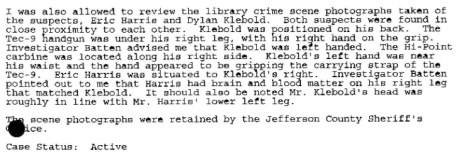
It says "right" leg, but I think that's a typo or the investigator writing the summary transposed R/L in his mind when writing this.
Q: Did SWAT chase Harris & Klebold up to the library?
There has been speculation that SWAT may have chased Harris & Klebold up the stairs to the library. There are a few reasons to consider this possibility. First, Matthew DePew heard a suspect say, “one’s coming in.” (Although, a student in the cafeteria yelled "he's coming in!" when Klebold entered the cafeteria, so that could be what DePew heard). Second, SWAT admits to have sent in a team of 6 people within 20 minutes of the first 911 call. They were in the building. Also, Neil Gardner was in the building and this is actually well-documented. On the dispatch tapes, the dispatcher asks if #71 is still inside (71 was Gardner's unit number and how he identified himself to dispatchers that day). There was also a live .45 round on the library floor that was ejected from Gardner's weapon, so we know he cleared his Sig Sauer in the library (his official story is that he never entered the building).
The rest of this section will be completed soon!